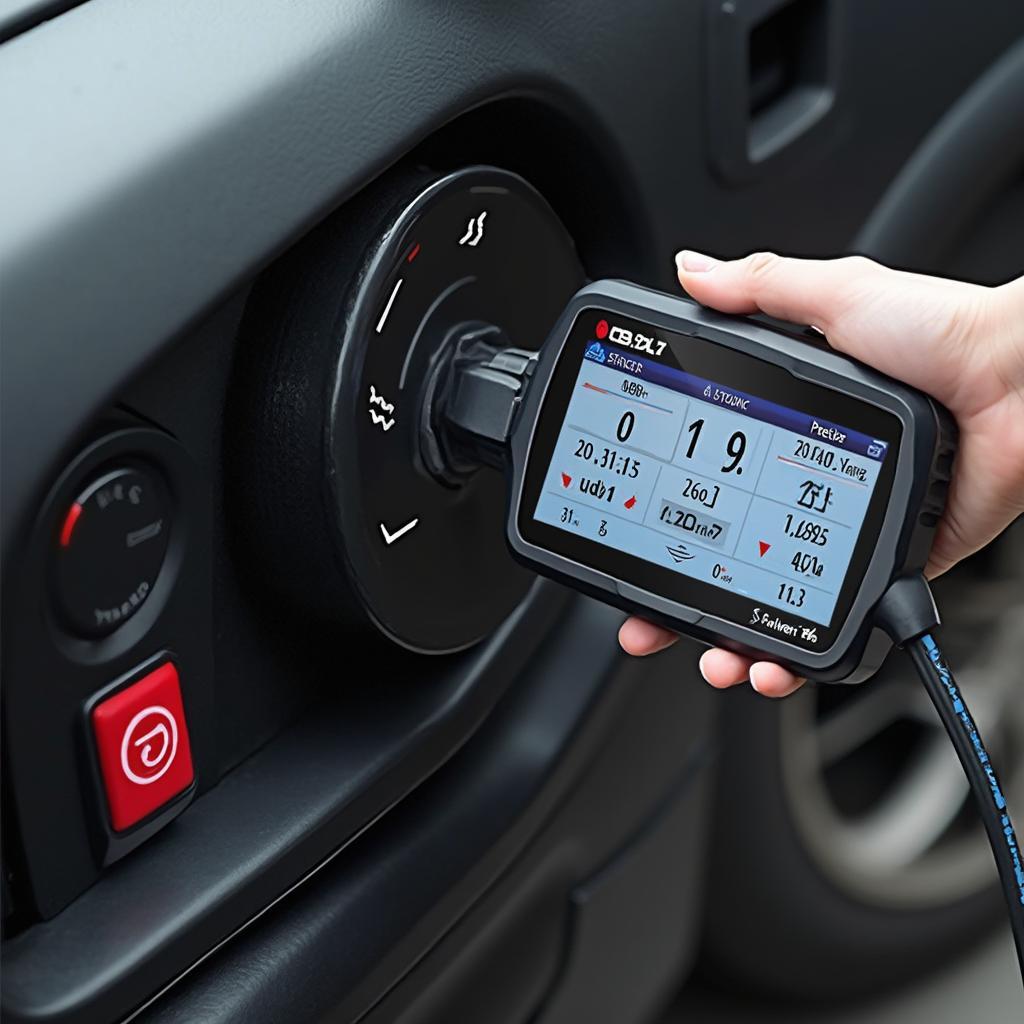OBD2 scanners and tire pressure monitoring are crucial for vehicle safety and performance. This guide delves into the relationship between OBD2 scanners and tire pressure, exploring how these diagnostic tools can help you maintain optimal tire health and avoid potential hazards. Learn how to use an OBD2 scanner to monitor tire pressure, understand its benefits, and choose the right scanner for your needs.
Understanding the importance of maintaining correct tire pressure is paramount. Underinflated tires can lead to reduced fuel economy, increased wear and tear, and a higher risk of blowouts. Overinflated tires, on the other hand, can result in a harsh ride, decreased traction, and uneven tire wear. An OBD2 scanner, particularly one equipped with TPMS (Tire Pressure Monitoring System) capabilities, can be an invaluable tool in ensuring your tires are properly inflated. Find out more about how an obd2 tpms scanner can benefit you.
How Does an OBD2 Scanner Read Tire Pressure?
An OBD2 scanner with TPMS functionality communicates with your vehicle’s onboard TPMS sensors, which are located inside each tire. These sensors continuously monitor tire pressure and temperature and transmit this data wirelessly to the vehicle’s ECU (Engine Control Unit). The OBD2 scanner then accesses this information through the OBD2 port and displays it on its screen. This allows you to quickly and easily check the pressure in each tire without needing a separate gauge. Some advanced scanners can even provide real-time data, showing you how tire pressure changes as you drive. Are you looking for the best obd2 scanner with tpms function? We’ve compiled a list to help you find the perfect one.
 OBD2 Scanner Reading Tire Pressure
OBD2 Scanner Reading Tire Pressure
Benefits of Using an OBD2 Scanner for Tire Pressure Monitoring
Using an OBD2 scanner for tire pressure monitoring offers several advantages:
- Convenience: Quickly check all tire pressures without leaving the driver’s seat.
- Accuracy: Get precise readings directly from the TPMS sensors.
- Early Detection: Identify slow leaks and other pressure issues before they become serious.
- Enhanced Safety: Maintain optimal tire pressure for improved handling and braking.
- Improved Fuel Economy: Properly inflated tires can contribute to better fuel efficiency.
Choosing the Right OBD2 Scanner for Tire Pressure
Not all OBD2 scanners are created equal. When selecting a scanner for tire pressure monitoring, consider the following factors:
- TPMS Compatibility: Ensure the scanner is compatible with your vehicle’s TPMS system.
- Features: Look for features like real-time data, diagnostic trouble codes (DTCs), and the ability to reset the TPMS light.
- Ease of Use: Choose a scanner with a user-friendly interface and clear display.
- Price: OBD2 scanners range in price, so consider your budget and needs. Learn more about how to read tire pressures with an obd2 scanner.
Troubleshooting Common OBD2 Scanner Tire Pressure Issues
Sometimes, you might encounter issues when using an OBD2 scanner to read tire pressure. Here are some common problems and solutions:
- Scanner Not Connecting: Check the OBD2 port connection and ensure the scanner is powered on.
- Inaccurate Readings: Verify that the TPMS sensors are functioning correctly and that the scanner is compatible with your vehicle.
- TPMS Light Stays On: After adjusting tire pressure, you may need to reset the TPMS light using the scanner or by following your vehicle’s specific procedure. Check out our article about obd2 link for additional information.
What if my OBD2 scanner isn’t reading tire pressure?
First, ensure your scanner has TPMS capabilities. If it does, double-check the connection and compatibility with your vehicle.
Can I use any OBD2 scanner to read tire pressure?
No, only scanners specifically designed with TPMS functionality can read tire pressure data.
Conclusion
An OBD2 scanner with TPMS functionality is a powerful tool for maintaining proper tire pressure, ensuring safety, and maximizing fuel efficiency. By understanding how these scanners work and choosing the right one for your needs, you can take proactive steps to keep your tires in optimal condition and prevent potential problems on the road. Regularly monitoring your obd2 scanner tire pressure is key for a safe and efficient driving experience. Don’t fall for scams – learn more about is the eco obd2 a scam.
FAQ
- How often should I check my tire pressure with an OBD2 scanner? At least once a month.
- Can an OBD2 scanner diagnose TPMS sensor problems? Yes, many scanners can detect faulty sensors.
- Do I need a professional to use an OBD2 scanner for tire pressure? No, it’s designed for easy DIY use.
- What are the signs of a failing TPMS sensor? A constantly illuminated TPMS light or consistently inaccurate readings.
- How do I reset the TPMS light after adjusting tire pressure? Consult your vehicle’s owner’s manual or use a TPMS reset tool.
- Are all OBD2 scanners compatible with all vehicles? Generally, yes, but always double-check compatibility.
- Where can I purchase a reliable OBD2 scanner with TPMS functionality? Reputable auto parts stores and online retailers.
Need support? Contact us via WhatsApp: +1(641)206-8880, Email: cardiagtechworkshop@gmail.com or visit us at 789 Elm Street, San Francisco, CA 94102, USA. We have a 24/7 customer service team.

